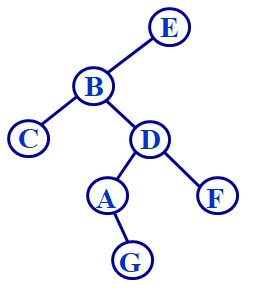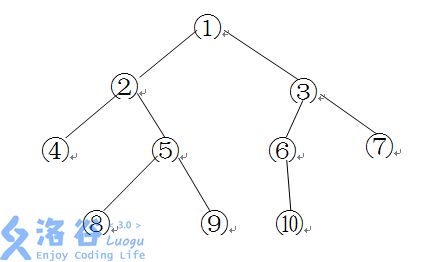【树】二叉树顺序结构
二叉树顺序存储方式,定义了数据域,左结点,右结点,和父节点
#define MAXLen 100
typedef char Data;
typedef struct ChainTree{
Data NodeData; //元素数据
struct ChainTree *LsonNode; //左子树结点指针
struct ChainTree *RsonNode; //右子树结点指针
struct ChainTree *PerentNode; //父结点指针
}ChainTreeType;
ChainTreeType *root=NULL;
根据上面的数据结构的方式,我们来定义个完整的二叉树:
第一步:定义一个数据结构
#define MAXLen 20 //最大长度
typedef char Data; //定义元素类型
typedef struct CBT{ //定义二叉树结点类型
Data data;
struct CBT *left;
struct CBT *right;
}CBTType;
第二步:初始化二叉树,
在使用顺序表之前,首先要初始化二叉树,代码中只需要将一个结点设置为二叉树的根结点。那么我们需要首先申请内存,然后由确定一个根结点数据,并将指向左子树和右子树的指针设置为空,就完成了二叉树的初始化工作。
CBTType *InitTree(){
CBTType *node;
if(node=(CBTType*)malloc(sizeof(CBTType))) //申请内存空间
{
print("please enter data of root node:\n");
scanf("%s",&node->data); //输入根节点数据
node->left=NULL; // 左结点和右结点都设置为空
node->right=NULL;
if(node!=NULL){
return node;
}
else{
return NULL;
}
}
return NULL;
}
第三步:添加数据,
添加结点就是在二叉树中添加结点数据。添加结点时除了要输入结点数据外,还需要指定其父结点,以及添加的结点时作为左子树还是作为右子树。我们输入参数treeNode为二叉树的根结点,传入根结点方便在代码中进行查找。代码中首先申请内存,然后由用户输入二叉树结点数据,并设置左右子树为空。接着指定其父结点,最后设置其作为左子树还是作为右子树。
void AddTreeNode(CBTType *treeNode) //添加结点
{
CBTType *pnode, *parent;
DATA data;
char menusel; //定义操作符
if(pnode=(CBTTYPE*)malloc(sizeof(CBTType)))//分配内存
{
printf("please enter CBTTree data:\n");
fflush(stdin);//stdin:标准输入流,fflush(stdin)清空输入缓存区。
//fflush(stdout) 强制显示输出缓冲区,rewind(stdin) 也可以清空输入缓存区,可以屏蔽回车符号。
scanf("%s",&pnode->data);
pnode->left=NULL; //设置左右树为空
pnode->right=NULL;
printf("please enter parent data of CBTTree");
fflush(stdin);
scanf("%s", &data);
parent=TreeFindNode(treeNode.data);//查找指定数的结点
if(!parent){ //如果没有找到
printf("does not found parent node!");
free(pnode); //释放创建的结点内存
return;
}
printf("1.add this node to left tree\n2.add this node to right tree\n");
do
{
menusel=getch(); //输入选择项,操作符
menusel-='0';
if(menusel==1 || menusel==2)
{
if(parent==NULL){
printf("the parent node does not exist, please set parent node first!";)
}
else{
switch(menusel)
{
case 1: //添加到左结点
if(parent->left){ //左子树不为空
printf("left node can't empty!");
}
else{
parent->left = pnode;
}
break;
case 2: //添加到右结点
if(parent->right){ // 右结点不为空
printf("Right node can't empty!'");
}
else{
parent->right = pnode;
}
break;
default:
printf("invalid input!\n");
}
}
}
}while(menusel!=1 && menusel!=2);
}
}
第四步:查找结点
查找结点就是遍历二叉树中的每一个结点,逐个比较数据,当找到目标数据时将返回该数据所在结点的指针。我们这里输入参数treeNode为待查找的二叉树的根结点,输入参数data为待查找的结点数据,代码中首先判断根结点是否为空,然后分别向左右子树递归查找。如果当前结点的数据与查找数据相等,则返回当前结点的指针。
CBTType *TreeFineNode(CNBType *treeNode, DATA data){
CBTType *ptr;
if(treeNode == NULL){
return NULL;
}
else{
if(treeNode->data==data){
return treeNode;
}
else{ //分别向左右子树递归查找。
if(ptr==TreeFindNode(treeNode->left,data)){
return ptr;
}
else if(ptr==TreeFindNode(treeNode->right,data)){
return ptr;
}
else{
return NULL;
}
}
}
}
第5步:获取左子树/右子树
获取左子树就是返回当前结点的左子树结点的值,由于我们在二叉树结构中定义了相应的指针,
所以操作就比较简单了。其中参数treeNode为二叉树的一个结点。代码将返回该结点的左子树的指针。 右子树和左子树的做法相同。
CBTType *TreeleftNode(CBTType *treeNode)
{
if(treeNode)
{
return treeNode->left; //返回值
}
else
{
return NULL;
}
}
CBTType *TreerightNode(CBTType *treeNode)
{
if(treeNode){
return treeNode->right;
}
else
{
return NULL;
}
}
第6步:判断空树
判断空树就是判断一个二叉树结构是否为空。如果是空树,则表示该二叉树结果中没有数据。
参数treeNode为待判断的二叉树的根结点。该函数检查二叉树是否为空,为空则返回1,否则返回0.
int TreeIsEmpty(CBTType *treeNode)
{
if(treeNode){
return 0;
}
else
{
return 1;
}
}
第7步:计算二叉树的深度。
计算二叉树的深度就是计算二叉树中结点的最大层数,这里往往需要采用递归算法来实现, 另外还可以使用迭代的方法来实现。
递归方法:
- 如果根节点为空,返回0。
- 否则,递归计算左子树和右子树的深度。
- 返回左右子树深度的较大值+1,即为整个树的深度。
int TreeDepth(CBTType *treeNode)
{
int depleft,depright;
if(treeNode==NULL)
{
return 0; //对于空树,深度为0;
}
else
{
depleft=TreeDepth(treeNode->left); //左子树深度(递归调用)
deprgiht=TreeDepth(treeNode->right); //右子树深度(递归调用)
//return max(depleft, deprgiht) + 1;
if(depleft>deprifht)
{
return depleft+1;
}
else{
return depright+1;
}
}
}
迭代方法:
使用一个队列存储每一层的节点。
首先将根节点入队。
当队列不为空时,取出队列中所有的节点,并将它们的非空子节点入队。
每一轮结束后,深度+1。
1
/ \
2 3
/ \ /
4 5 6 7
首先将根节点(1, 1)压入栈中,其中1表示深度为1。
接着弹出栈顶节点(1, 1),并将其子节点(2, 2)和(3, 2)分别压入栈中。
再弹出栈顶节点(3, 2),不需要将其子节点压入栈中。
接着弹出栈顶节点(2, 2),并将其子节点(4, 3)和(5, 3)分别压入栈中。
再依次弹出栈顶节点(5, 3)、(4, 3),不需要将其子节点压入栈中。
最后栈为空,返回最大深度3。
int maxDepth(TreeNode* root) {
if(!root) return 0;
stack<pair<TreeNode*, int>> s; // pair中存放节点和深度
s.push(make_pair(root, 1));
int depth = 0;
while(!s.empty()) {
auto cur = s.top();
s.pop();
depth = max(depth, cur.second);
if(cur.first->right) s.push(make_pair(cur.first->right, cur.second+1));
if(cur.first->left) s.push(make_pair(cur.first->left, cur.second+1));
}
return depth;
}
make_pair 是 C++ STL 中的一个函数模板,用于创建一个 pair 对象,即将两个值(可以是不同类型)打包成一对。它的声明如下:
template<class T1, class T2>
constexpr pair<V1,V2> make_pair(T1&& t, T2&& u);
其中,T1 和 T2 可以是任意类型,t 和 u 是对应类型的参数,可以是左值或右值引用。make_pair 函数会根据 t 和 u 的类型自动推导出 pair 的类型,返回一个值为 pair 类型的对象。
constexpr是C++11引入的关键字,用于指示编译器在编译期间计算表达式的值,并将其用于编译时计算。它可以应用于函数、变量或者类的成员函数和静态成员变量,以及常量表达式。
当一个函数或变量被声明为constexpr时,它的值必须可以在编译期间计算,这意味着它不能有任何运行时的副作用,例如读取文件或从网络获取数据。其主要应用包括:
常量表达式:使用constexpr将变量或函数声明为常量表达式,可以在编译期间进行计算,并且被用作常量。
性能优化:使用constexpr可以告诉编译器在编译期间计算表达式,从而在运行时节省时间和资源。
例如,可以这样使用 make_pair 函数:
#include 这段代码中,我们用 make_pair 函数将一个 int 类型的变量 a 和一个 double 类型的变量 b 打包成了一个 pair 对象 p,并输出了其中的两个值。
第八步:清空二叉树
清空二叉树就是将二叉树变成一个空树,这里也需要使用递归算法来实现。
void clearTree(CBTType *treeNode){
if(treeNode)
{
clearTree(treeNode->left); //清空左子树
clearTree(treeNode->right); //清空右子树
free(treeNode); //释放当前结点所占内存
treeNode=NULL;
}
}
第九步:显示结点数据。
显示结点数据就是显示当前结点的数据内容。
其中参数p为待显示的结点。
void TreeNodeData(CBTType *p)
{
printf("%c", p->data);
}
遍历二叉树
遍历二叉树就是逐个查找二叉树中所有的结点,这是二叉树的基本操作,因为很多操作都需要首先遍历整个二叉树,由于二叉树的特殊结构,我们有多种方法来进行遍历。
按层遍历算法是最直观的遍历算法。首先处理第1层即根结点,再处理第1根结点的左右子树,
也即是第2层…就这样循环处理,就可以逐层遍历。
参数treeNode为需要遍历的二叉树根结点,而函数指针p是一个需要对结点进行操作的函数。
在整个代码处理过程中,首先从根结点开始,将每层的结点逐步进入队列,这样就可得到按层
遍历的效果。
二叉树按层遍历的过程,也叫做广度优先遍历,可以使用队列来实现。
具体步骤如下:
-
首先将根节点入队。
-
当队列不为空时,依次进行如下操作:
弹出队首元素,并输出该元素的值。
如果该元素有左子树,则将左子树入队。
如果该元素有右子树,则将右子树入队。
-
遍历完成后,队列中没有元素,算法结束。
假设有如下一棵二叉树:
1
/ \
2 3
/ \
4 5 6
按层遍历的过程为:
先访问根节点1,
然后按照从上到下、从左到右的顺序依次访问其左右子节点2、3,
再按照同样的方式依次访问2的左右子节点4、5、3的右子节点6。
因此,按层遍历的结果为:1, 2, 3, 4, 5, 6。
void LevelFree(CBTType *treeNode, void(*TreeNodeData)(CBTType *p)) //按层遍历
{
CBTType *p;
CBTType *q[MAXLEN]; //定义一个顺序栈
int head=0, tail=0;
if(treeNode) //如果队首指针不为空
{
tail=(tail+1)%MAXLEN; //计算循环队列队尾序号
q[tail]=treeNode; //将二叉树根指针进队
}
while(head!=tail) //队列不为空,进行循环
{
head=(head+1)%MAXLEN; //计算循环队列的队首序号
p=q[head]; //获取队首元素
TreeNodeData(p); //处理队首元素
if(p->left!=NULL) //如果结点存在左子树
{
tail=(tail+1)%MAXLEN; //计算循环队列的队尾序号
q[tail]=p->left; //将左子树指针进队
}
if(p->right!=NULL) //如果结点存在右子树
{
tail=(tail+1)%MAXLEN; //计算循环队列的队尾序号
q[tail]=p->right; //将右子树指针进队
}
}
}
我们也可以使用队列来实现:
#include 先序遍历算法
先序遍历算法就是先按中序遍历左子树,再访问根结点,最后按中序遍历右子树。
程序可以按照递归的思路来遍历整个二叉树。
参数treeNode为需要遍历的二叉树根结点,函数指针p是一个需要对结点进行操作的函数。
void DLRTree(CBTType *treeNode,void(*TreeNodeData)(CBTType *p)) //先序遍历
{
if(treeNode)
{
TreeNodeData(treeNode); //显示结点的数据
DLRTree(treeNode->left,TreeNodeData);
DLRTree(treeNode->right,TreeNodeData);
}
}
中序遍历算法
中序遍历就是先访问根结点,在按先序遍历左子树,最后按先序遍历右子树。
void LDRTree(CBTType *treeNode,void(*TreeNodeData)(CBTType *p)) //中序遍历
{
if(treeNode)
{
LDRTree(treeNode->left,TreeNodeData); //中序遍历左子树
TreeNodeData(treeNode); //显示结点数据
LDRTree(treeNode->right,TreeNodeData); //中序遍历右子树
}
}
后序遍历算法:
后序遍历算法就是先按后序遍历左子树,再按后序遍历右子树,最后访问根结点。
void LRDTree(CBTType *treeNode,void(*TreeNodeData)(CBTType *p)) //后序遍历
{
if(treeNode)
{
LRDTree(treeNode->left, TreeNodeData); //后序遍历左子树
LRDTree(treeNode->right,TreeNodeData); //后序遍历右子树
TreeNodeData(treeNode); //显示结点数据
}
}
二叉树操作实例
#include【基础题1】求二叉树的最大层数(最大深度)
递归法
1.确定递归函数的参数和返回值:参数就是传入树的根节点,返回就返回这棵树的深度,所以返回值为int类型。
代码如下:
int getDepth(TreeNode* node)
2.确定终止条件:如果为空节点的话,就返回0,表示高度为0。
代码如下:
if (node == NULL) return 0;
3.确定单层递归的逻辑:先求它的左子树的深度,再求的右子树的深度,最后取左右深度最大的数值 再+1 (加1是因为算上当前中间节点)就是目前节点为根节点的树的深度。
代码如下:
int leftDepth = getDepth(node->left); // 左
int rightDepth = getDepth(node->right); // 右
int depth = 1 + max(leftDepth, rightDepth); // 中
return depth;
#include 输入:abc##de#g##f### (前序)
输出:5
【基础题2】二叉树的最小深度
#include 输入:A B # # C D # # #(前序)
输出:2
【基础题3】平衡树_Balanced Binary Tree (Easy)(AVL)
【基础题4】 两节点的最长路径

输入 EBC##DA#G##F###
输出:4
路径为:E->B->D->A->G->NULL
#include【基础题5】翻转树
【基础题6】 归并两棵树
【基础题7】判断路径和是否等于一个数
【基础题8】 统计路径和等于一个数的路径数量
【基础题9】树的对称
【基础题10】求二叉树的镜像
【例题1】普通二叉树(简化版)
题目描述
您需要写一种数据结构,来维护一些数( 都是 1 0 9 10^9 109 以内的数字)的集合,最开始时集合是空的。其中需要提供以下操作,操作次数 q q q 不超过 1 0 4 10^4 104:
- 查询 x x x 数的排名(排名定义为比当前数小的数的个数 + 1 +1 +1。若有多个相同的数,应输出最小的排名)。
- 查询排名为 x x x 的数。
- 求 x x x 的前驱(前驱定义为小于 x x x,且最大的数)。若未找到则输出 − 2147483647 -2147483647 −2147483647。
- 求 x x x 的后继(后继定义为大于 x x x,且最小的数)。若未找到则输出 2147483647 2147483647 2147483647。
- 插入一个数 x x x。
输入格式
第一行是一个整数 q q q,表示操作次数。
接下来 q q q 行,每行两个整数 o p , x op,x op,x,分别表示操作序号以及操作的参数 x x x。
输出格式
输出有若干行。对于操作 1 , 2 , 3 , 4 1,2,3,4 1,2,3,4,输出一个整数,表示该操作的结果。
样例 #1
样例输入 #1
7
5 1
5 3
5 5
1 3
2 2
3 3
4 3
样例输出 #1
2
3
1
5
[例题2] 求先序排列
题目描述
给出一棵二叉树的中序与后序排列。求出它的先序排列。(约定树结点用不同的大写字母表示,且二叉树的节点个数 $ \le 8$)。
输入格式
共两行,均为大写字母组成的字符串,表示一棵二叉树的中序与后序排列。
输出格式
共一行一个字符串,表示一棵二叉树的先序。
样例 #1
样例输入 #1
BADC
BDCA
样例输出 #1
ABCD
提示
【题目来源】
NOIP 2001 普及组第三题
[例题3]二叉树问题
题目描述
如下图所示的一棵二叉树的深度、宽度及结点间距离分别为:
- 深度: 4 4 4
- 宽度: 4 4 4
- 结点 8 和 6 之间的距离: 8 8 8
- 结点 7 和 6 之间的距离: 3 3 3
其中宽度表示二叉树上同一层最多的结点个数,节点 u , v u, v u,v 之间的距离表示从 u u u 到 v v v 的最短有向路径上向根节点的边数的两倍加上向叶节点的边数。
给定一颗以 1 号结点为根的二叉树,请求出其深度、宽度和两个指定节点 x , y x, y x,y 之间的距离。
输入格式
第一行是一个整数,表示树的结点个数 n n n。
接下来 n − 1 n - 1 n−1 行,每行两个整数 u , v u, v u,v,表示树上存在一条连接 u , v u, v u,v 的边。
最后一行有两个整数 x , y x, y x,y,表示求 x , y x, y x,y 之间的距离。
输出格式
输入三行,每行一个整数,依次表示二叉树的深度、宽度和 x , y x, y x,y 之间的距离。
样例 #1
样例输入 #1
10
1 2
1 3
2 4
2 5
3 6
3 7
5 8
5 9
6 10
8 6
样例输出 #1
4
4
8
提示
对于全部的测试点,保证 1 ≤ u , v , x , y ≤ n ≤ 100 1 \leq u, v, x, y \leq n \leq 100 1≤u,v,x,y≤n≤100,且给出的是一棵树。
[例题4]医院设置
题目描述
设有一棵二叉树,如图:
其中,圈中的数字表示结点中居民的人口。圈边上数字表示结点编号,现在要求在某个结点上建立一个医院,使所有居民所走的路程之和为最小,同时约定,相邻接点之间的距离为 1 1 1。如上图中,若医院建在1 处,则距离和 = 4 + 12 + 2 × 20 + 2 × 40 = 136 =4+12+2\times20+2\times40=136 =4+12+2×20+2×40=136;若医院建在 3 3 3 处,则距离和 = 4 × 2 + 13 + 20 + 40 = 81 =4\times2+13+20+40=81 =4×2+13+20+40=81。
输入格式
第一行一个整数 n n n,表示树的结点数。
接下来的 n n n 行每行描述了一个结点的状况,包含三个整数 w , u , v w, u, v w,u,v,其中 w w w 为居民人口数, u u u 为左链接(为 0 0 0 表示无链接), v v v 为右链接(为 0 0 0 表示无链接)。
输出格式
一个整数,表示最小距离和。
样例 #1
样例输入 #1
5
13 2 3
4 0 0
12 4 5
20 0 0
40 0 0
样例输出 #1
81
提示
数据规模与约定
对于 100 % 100\% 100% 的数据,保证 1 ≤ n ≤ 100 1 \leq n \leq 100 1≤n≤100, 0 ≤ u , v ≤ n 0 \leq u, v \leq n 0≤u,v≤n, 1 ≤ w ≤ 1 0 5 1 \leq w \leq 10^5 1≤w≤105。
【例题5】淘汰赛
题目描述
有 2 n 2^n 2n( n ≤ 7 n\le7 n≤7)个国家参加世界杯决赛圈且进入淘汰赛环节。已经知道各个国家的能力值,且都不相等。能力值高的国家和能力值低的国家踢比赛时高者获胜。1 号国家和 2 号国家踢一场比赛,胜者晋级。3 号国家和 4 号国家也踢一场,胜者晋级……晋级后的国家用相同的方法继续完成赛程,直到决出冠军。给出各个国家的能力值,请问亚军是哪个国家?
输入格式
第一行一个整数 n n n,表示一共 2 n 2^n 2n 个国家参赛。
第二行 2 n 2^n 2n 个整数,第 i i i 个整数表示编号为 i i i 的国家的能力值( 1 ≤ i ≤ 2 n 1\leq i \leq 2^n 1≤i≤2n)。
数据保证不存在平局。
输出格式
仅一个整数,表示亚军国家的编号。
样例 #1
样例输入 #1
3
4 2 3 1 10 5 9 7
样例输出 #1
1

